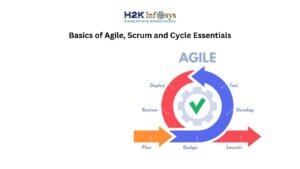Product roadmaps are a tremendous tool for any SaaS firm, whether they are internal or public. They serve as the exclusive informational resource for all parties concerned with the product planning.
With product roadmaps, you can:
- Organize the organization’s development efforts.
- Get the perspectives of other departments on product plans by coordinating with them.
- Inform and excite your consumers and stakeholders.
However, they are only genuinely beneficial if you adhere to a few fundamental best practices for product roadmaps. A good online Agile PSM certification course will explain the entirety of product roadmaps.
A list of important delivery emphasis areas makes up a product roadmap. It primarily responds to two queries:
- What time do you intend to release it?
- What is the main concern?
One must distinguish between a project plan and a product roadmap. A roadmap outlines our intended course for a product and communicates our clear vision for it.
Capturing the value of the product that will be provided to the client is the roadmap’s primary goal. It is also vital to avoid seeing roadmaps as product backlogs, which are feature lists that need to be sized and estimated. Nevertheless, a strong roadmap inevitably results in a product backlog.
- Keep your roadmap updated.
Like any popular source of knowledge, product roadmaps are only helpful if they are updated.
Internally, not updating the roadmap results in confusion and disarray. Other departments will be even more perplexed, and your product team will be lost.
An outdated roadmap is meaningless to stakeholders on the outside, such as investors and customers. They won’t receive any helpful information regarding what is to come. In the worst situation, they utterly misunderstand what is being worked on. Bring on the frustration and rage. The stage your organization and product are in determines how frequently you should update your roadmap.
There are two basic techniques to guarantee that your roadmap is continuously updated in the early stages:
Review regularly.
Even if they are not currently updating or revising the plan, the product team should still frequently evaluate it. It’s up to you how frequently you want to do it weekly, monthly, or however. You’re good as long as you review it frequently to ensure that everything is in its proper place.
Make it a logical conclusion to add things to the roadmap.
Ensure that any action items, documents, and other items decided upon in meetings are always added right after. Any difficult decisions should be included in your roadmap as soon as possible. It’s simple to forget about stuff. Every omitted item leads to confusion if other departments or clients are also looking at your roadmap.
It will be clear and consistent to update the roadmap, which will prevent confusion and ensure that nothing gets missed.
- Don’t overpromise on your roadmap.
Making a roadmap is enjoyable. For developers and product managers, it almost feels like a matter of pride. Everyone will be eager to view the roadmap after you add stuff to it.
But we’ve previously discussed the idea of underpromising and overdelivering. A product roadmap is only helpful if it is realistic, just like updating it. Giving users a way to comment is a crucial component of the best practices for product roadmaps.
Consider the extent of each item you include in your roadmap and whether it is really feasible. Don’t include it in the roadmap if it isn’t.
Keep in mind that your employees and clients will be eager to learn about your ambitions. They won’t be thrilled, though, if things start going slowly or not at all.
If you consistently let people down, you risk losing their trust. It’s not what you want.
It’s always preferable to underpromise and exceed expectations than the opposite.
- Make sure you have a place for feedback.
Ideal product roadmaps are developed with input from all relevant corporate departments as well as consumer feedback and demands.
However, after the roadmap has been created, you shouldn’t eliminate all feedback alternatives. It’s common to desire to “lock up” your roadmap once it has been established in order to bring it to a “close.”
However, roadmaps are never final, particularly in the software industry. On the basis of fresh data and requests, plans are modified. The priorities end up being different things.
Additionally, road charts are not typically very detailed. This implies that extra queries or suggestions can come from individuals who aren’t directly involved in product planning. As a result, your roadmap might need to be updated.
Therefore, it’s crucial to create a simple mechanism for providing input on (and asking questions about) your roadmap at all times.
Both internally and publicly, that means:
- Supplying a location where the product plans can be discussed.
- Establishing a simple means of getting in touch with the person responsible for updating the roadmap.
- Stating clearly the best way to reach the entire firm with their roadmap.
Always keep in mind that further comments and suggestions are beneficial. Your roadmap will become more varied and flexible to developments outside of your product as a result.
- Make ownership clear.
It’s crucial to identify who is responsible for each item on internal product roadmaps, especially.
In this manner, everyone will know who to contact if there is a problem or a query. If not, the general product manager will be inundated with inquiries and issues, forcing them to reassign.
Additionally, the people directly accountable will become more aware, involved, and proud of the work they are doing when ownership is explicit and apparent inside the roadmap.
Conclusion
Product roadmaps are very helpful, whether they are utilized privately or publicly.
They can be used to inform stakeholders of impending events and maintain organization among all of your company’s departments. Product road mapping serves as a conduit between gathering customer feedback and carrying it out. Your roadmap will spark discussions about the potential of your product and provide background information for the work you’re doing. Keep your product roadmap up-to-date, accessible, and well-maintained. You’ll spend less time wasting and your entire product planning process will be streamlined. Check out the online Agile training to learn more about product roadmaps.





























